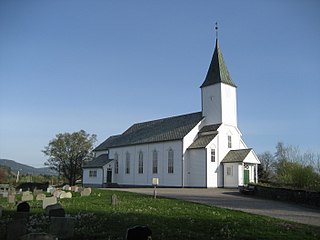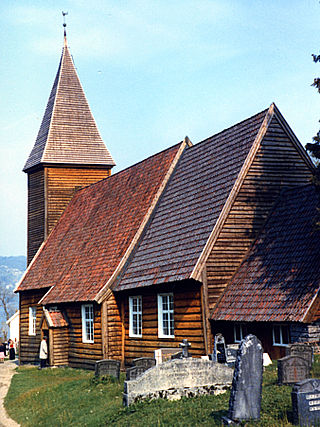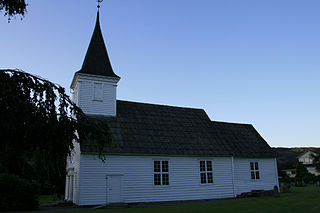
Hoff Church is a parish church of the Church of Norway in Østre Toten Municipality in Innlandet county, Norway. It is located in the village of Kraby, just east of the municipal centre of Lena. It is the church for the Hoff parish which is part of the Toten prosti (deanery) in the Diocese of Hamar. The white, stone church was built in a long church design during the 12th century using plans drawn up by an unknown architect. The church seats about 332 people.

Bergen Cathedral is a cathedral in the city of Bergen in Vestland county, Norway. It is the episcopal seat of the Diocese of Bjørgvin as well as the seat of the "Bergen domkirke" parish and the seat of the Bergen domprosti (arch-deanery). It is part of the Church of Norway. The first recorded historical reference to this church is dated 1181. It retains its ancient dedication to Saint Olaf. The cathedral seats about 900 people.

St Mary's Church is a parish church of the Church of Norway in Bergen Municipality in Vestland county, Norway. It is located in the Bryggen area in the central part of the city of Bergen. It is one of the churches for the Bergen Cathedral parish which is part of the Bergen domprosti (arch-deanery) in the Diocese of Bjørgvin. The large, gray stone church was built in a long church design using plans drawn up by an unknown architect. The church seats about 240 people. The construction of the church is believed to have started in the 1130s or 1140s and completed around 1180, making this church the oldest remaining building in the whole city of Bergen. There have been a few fires that burned the church, as well as several renovations and reconstructions, most recently in 2013.

Nykirken is a parish church of the Church of Norway in Bergen Municipality in Vestland county, Norway. It is located in the Nordnes area of the city of Bergen. It is one of the churches for the Bergen Cathedral parish which is part of the Bergen domprosti (arch-deanery) in the Diocese of Bjørgvin.

St George's Church, Bergen is a historic church of the Church of Norway in Bergen Municipality in Vestland county, Norway. This is also the site of the Leprosy Museum. Although it is no longer regularly used, it is one of the churches in the Bergen domprosti parish which is part of the Bergen domprosti (arch-deanery) in the Diocese of Bjørgvin. The green, wooden church was built in a cruciform design in 1706 using plans drawn up by an unknown architect. The church seats about 125 people.

Vereide Church is a medieval parish church of the Church of Norway in Gloppen Municipality in Vestland county, Norway. It is the only stone church in the Nordfjord region. It is located in the village of Vereide, along the eastern coast of the Gloppefjorden. It is one of the four churches for the Gloppen parish which is part of the Nordfjord prosti (deanery) in the Diocese of Bjørgvin. The white, stone church was built in a long church style in the 12th century by an unknown architect. The church seats about 460 people.

Kinn Church is a parish church of the Church of Norway in Kinn Municipality in Vestland county, Norway. It is located on the small island of Kinn. It is one of two churches for the Kinn parish which is part of the Sunnfjord prosti (deanery) in the Diocese of Bjørgvin. The white, stone church was built in a long church design in the middle of the 12th century using plans drawn up by an unknown architect.

Førde Church is a parish church of the Church of Norway in Sunnfjord Municipality in Vestland county, Norway. It is located in the town of Førde. It is the church for the Førde parish which is part of the Sunnfjord prosti (deanery) in the Diocese of Bjørgvin. The white, wooden church was built in a long church design in 1885 using plans drawn up by the architect Jacob Wilhelm Nordan. The church seats about 475 people.

Ålhus Church is a parish church of the Church of Norway in Sunnfjord Municipality in Vestland county, Norway. It is located in the village of Ålhus on the northern shore of the lake Jølstravatnet. It is one of two churches for the Ålhus parish which is part of the Sunnfjord prosti (deanery) in the Diocese of Bjørgvin. The white, wooden church was built in a long church style in 1795 by the architect Gunder Gregoriussen Støfringshaug. The church seats about 168 people.

Leikanger Church is a parish church of the Church of Norway in Sogndal Municipality in Vestland county, Norway. It is located in the village of Leikanger, along the northern coast of the Sognefjorden. It is the church for the Leikanger parish which is part of the Sogn prosti (deanery) in the Diocese of Bjørgvin. The white, stone church has a large wooden steeple. The building was constructed in a long church design around the year 1250 using plans drawn up by an unknown architect. The church seats about 220 people.

Dale Church is a parish church of the Church of Norway in Luster Municipality in Vestland county, Norway. It is located in the village of Luster on the western shore of the Lustrafjorden. It is the church for the Dale parish which is part of the Sogn prosti (deanery) in the Diocese of Bjørgvin. The red and white, stone church was built in a long church design around the year 1240 using designs by an unknown architect. The church seats about 200 people.

Jostedal Church is a parish church of the Church of Norway in Luster Municipality in Vestland county, Norway. It is located in the village of Jostedal. It is the church for the Jostedal parish which is part of the Sogn prosti (deanery) in the Diocese of Bjørgvin. The white, wooden church was built in a long church design around 1660 by builder Hans Ottesen Ravn using plans drawn up by an unknown architect. The church seats about 120 people.

Lindås Church is a parish church of the Church of Norway in Alver Municipality in Vestland county, Norway. It is located in the village of Lindås. It is one of the three churches for the Lindås parish which is part of the Nordhordland prosti (deanery) in the Diocese of Bjørgvin. The white, wooden, neo-gothic church was built in a long church design in 1865 using plans drawn up by the architect Ole Syslak. The church seats about 370 people.

Hamre Church is a parish church of the Church of Norway in Osterøy Municipality in Vestland county, Norway. It is located in the village of Hamre. It is the church for the Hamre parish which is part of the Åsane prosti (deanery) in the Diocese of Bjørgvin. The wooden church was built in a long church design in the late 1500s using plans drawn up by an unknown architect. The church seats about 350 people.

Voss Church is a parish church of the Church of Norway in Voss Municipality in Vestland county, Norway. It is located in the village of Vossevangen. It is the church for the Voss parish which is part of the Hardanger og Voss prosti (deanery) in the Diocese of Bjørgvin. The gray, stone church was built in a long church design in 1277 using plans drawn up by an unknown architect. The church seats about 460 people.

Vikøy Church is a parish church of the Church of Norway in Kvam Municipality in Vestland county, Norway. It is located in the village of Vikøy, a few kilometers south of the municipal centre of Norheimsund. It is one of the churches for the Vikøy parish which is part of the Hardanger og Voss prosti (deanery) in the Diocese of Bjørgvin. The white, wooden church was built in a long church design in 1838 using plans drawn up by the architect Hans Linstow. The church seats about 300 people.

Stord Church is a parish church of the Church of Norway in Stord Municipality in Vestland county, Norway. It is located in the town of Leirvik on the southern side of the island of Stord. It is the church for the Stord parish which is part of the Sunnhordland prosti (deanery) in the Diocese of Bjørgvin. The white, stone church was built in a long church design in 1857 using plans drawn up by the architects Andreas Grønning and Frederik Hannibal Stockfleth. The church seats about 400 people.

Fjelberg Church is a parish church of the Church of Norway in Kvinnherad Municipality in Vestland county, Norway. It is located on the small island of Fjelbergøya. It is one of the two churches for the Fjelberg og Eid parish which is part of the Sunnhordland prosti (deanery) in the Diocese of Bjørgvin. The white, wooden church was built in a long church design in 1722 using plans drawn up by an unknown architect. The church seats about 160 people.

Gjerde Church is a parish church of the Church of Norway in Etne Municipality in Vestland county, Norway. It is located in the Etnesjøen, just south of the village centre. It is one of the churches for the Etne parish which is part of the Sunnhordland prosti (deanery) in the Diocese of Bjørgvin. The white, wooden church was built in a long church design in 1676 using plans drawn up by an unknown architect. The church seats about 250 people.

Sande Church is a parish church of the Church of Norway in Holmestrand Municipality in Vestfold county, Norway. It is located in the village of Sande i Vestfold. It is the church for the Sande parish which is part of the Nord-Jarlsberg prosti (deanery) in the Diocese of Tunsberg. The white, stone church was built in a long church design around the year 1150 using plans drawn up by an unknown architect. The church seats about 350 people.




























